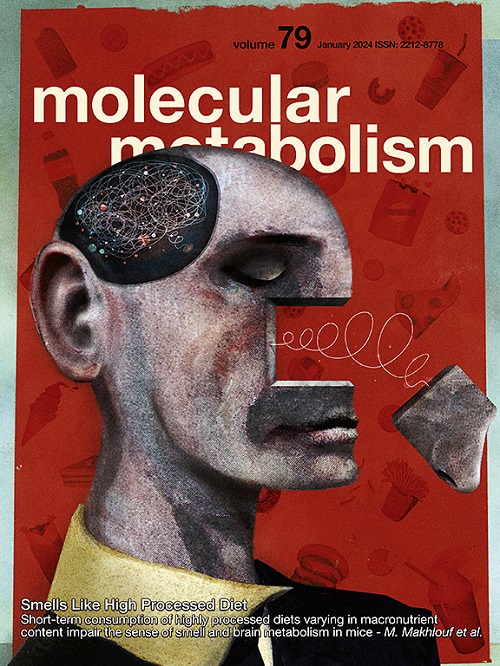通过下丘脑调节糖异生底物有效性来控制生理性葡萄糖稳态。
IF 6.6
2区 医学
Q1 ENDOCRINOLOGY & METABOLISM
引用次数: 0
摘要
目的:大脑在紧急情况下(如低血糖)以及在日常生理(如禁食)中动员葡萄糖。虽然大多数参与葡萄糖动员的下丘脑神经元群也参与代谢的其他方面,但下丘脑腹内侧核中表达胆囊收缩素b受体(VMHCckbr神经元)的神经元在低血糖期间支持葡萄糖的产生,而不控制能量稳态。然而,它们在日常葡萄糖生理中的作用以及它们参与支持葡萄糖动员的机制尚不清楚。方法:我们对长期沉默的VMHCckbr神经元小鼠进行连续血糖监测,以确定这些神经元在日常葡萄糖稳态中是否必需。以破伤风毒素为基础的慢性沉默和急性光遗传激活,随后分析肝脏糖代谢和白色脂肪组织脂解。结果:我们发现VMHCckbr神经元在短期禁食期间支持葡萄糖稳态,并参与糖异生底物动员和脂肪分解。VMHCckbr神经元动员葡萄糖不消耗肝糖原或增加糖异生基因表达,而是以β3-肾上腺素能受体(β3-AR)依赖的方式动员甘油。VMHCckbr神经元沉默后恢复甘油可用性可恢复葡萄糖。最后,VMHCckbr神经元的急性激活动员了甘油以外的其他糖异生底物。结论:VMHCckbr神经元代表了葡萄糖动员VMH神经元的一个独特子集,可能通过控制β3- ar介导的糖异生底物动员和脂肪分解来支持生理性葡萄糖稳态。不同的葡萄糖动员神经元群的存在,以不同的情境依赖的方式参与不同的机制,可能为大脑提供灵活性,以协调不同情况下适当的血糖反应。本文章由计算机程序翻译,如有差异,请以英文原文为准。
Control of physiologic glucose homeostasis via hypothalamic modulation of gluconeogenic substrate availability
Objectives
The brain mobilizes glucose in emergency situations such as hypoglycemia as well as during day-to-day physiology such as fasting. While most hypothalamic neuronal populations that contribute to glucose mobilization also contribute to other aspects of metabolism, neurons in the ventromedial nucleus of the hypothalamus that express the cholecystokinin b receptor (VMHCckbr neurons) support glucose production during hypoglycemia without controlling energy homeostasis. However, their role in day-to-day glucose physiology and the mechanisms they engage to support glucose mobilization is unclear.
Methods
We used continuous glucose monitoring in mice with chronically silenced VMHCckbr neurons to establish whether these neurons are required during day-to-day glucose homeostasis. Tetanus-toxin based chronic silencing and acute optogenetic activation were followed by analysis of hepatic glucose metabolism and white adipose tissue lipolysis.
Results
We found that VMHCckbr neurons support glucose homeostasis during short fasts and contribute to gluconeogenic substrate mobilization and lipolysis. VMHCckbr neurons mobilize glucose without depleting hepatic glycogen or increasing gluconeogenic gene expression, but instead mobilize glycerol in a β3-adrenergic receptor (β3-AR)-dependent manner. Restoring glycerol availability following VMHCckbr neuron silencing restores glucose. Finally, acute activation of VMHCckbr neurons mobilizes additional gluconeogenic substrates beyond glycerol.
Conclusions
VMHCckbr neurons represent a distinct subset of glucose-mobilizing VMH neurons that support physiologic glucose homeostasis, likely through control of β3-AR-mediated gluconeogenic substrate mobilization and lipolysis. The presence of different glucose-mobilizing neuronal populations that engage distinct mechanisms in a context-dependent manner may provide the brain with flexibility to coordinate the appropriate glycemic response to different circumstances.
求助全文
通过发布文献求助,成功后即可免费获取论文全文。
去求助
来源期刊

Molecular Metabolism
ENDOCRINOLOGY & METABOLISM-
CiteScore
14.50
自引率
2.50%
发文量
219
审稿时长
43 days
期刊介绍:
Molecular Metabolism is a leading journal dedicated to sharing groundbreaking discoveries in the field of energy homeostasis and the underlying factors of metabolic disorders. These disorders include obesity, diabetes, cardiovascular disease, and cancer. Our journal focuses on publishing research driven by hypotheses and conducted to the highest standards, aiming to provide a mechanistic understanding of energy homeostasis-related behavior, physiology, and dysfunction.
We promote interdisciplinary science, covering a broad range of approaches from molecules to humans throughout the lifespan. Our goal is to contribute to transformative research in metabolism, which has the potential to revolutionize the field. By enabling progress in the prognosis, prevention, and ultimately the cure of metabolic disorders and their long-term complications, our journal seeks to better the future of health and well-being.
 求助内容:
求助内容: 应助结果提醒方式:
应助结果提醒方式:


